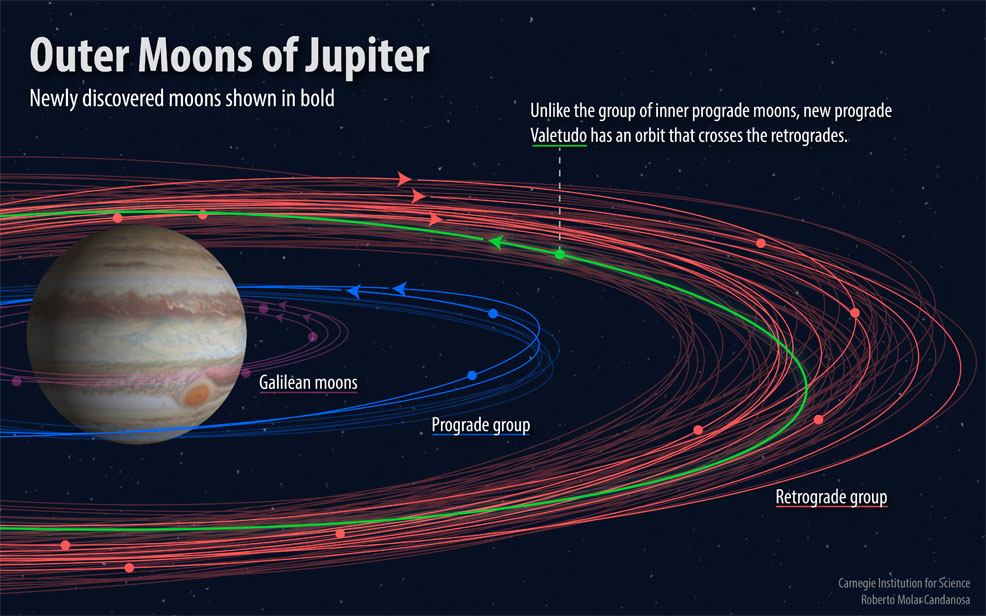
17th July 2018 12 new moons of Jupiter discovered Scientists led by Scott S. Sheppard report the discovery of 12 new satellites of Jupiter, taking its total number to 79. This includes one "oddball", named Valetudo, which is predicted to collide with a neighbouring moon in the distant future.
Twelve new moons have been found orbiting Jupiter – 11 "normal" outer moons, and one that is being called an "oddball." This brings Jupiter's total number of known satellites to a whopping 79, the most of any planet in our Solar System. All of the new moons are tiny, at one to three kilometres in size. A team led by Scott S. Sheppard, from the Carnegie Institution for Science Washington, D.C., began spotting the moons in the spring of 2017 while they were looking for more distant Solar System objects, as part of the hunt for a possible massive planet far beyond Pluto. "Jupiter just happened to be in the sky near the search fields where we were looking for extremely distant Solar System objects – so we were serendipitously able to look for new moons around Jupiter, while at the same time looking for planets at the fringes of our Solar System," says Sheppard. Gareth Williams at the International Astronomical Union's Minor Planet Center used the team's observations to calculate orbits for the newly found moons. "It takes several observations to confirm an object actually orbits around Jupiter," he explains. "So, the whole process took a year."
Nine of the new moons are part of a distant outer swarm that orbits in the retrograde, or opposite direction of Jupiter's spin rotation. These distant retrograde moons are grouped into at least three distinct orbital groupings. They are thought to be the remnants of three once-larger parent bodies that broke apart during collisions with asteroids, comets, or other moons. The newly discovered retrograde moons take about two years to orbit Jupiter. Two of the new discoveries are part of a closer, inner group of moons that orbit in the prograde, or same direction as the planet's rotation. These inner prograde moons all have similar orbital distances and angles of inclinations around Jupiter and so are thought to also be fragments of a larger moon that was broken apart. These two newly discovered moons take a little less than a year to travel around Jupiter. The 12th and final discovery "is a real oddball, and has an orbit like no other known Jovian moon," Sheppard explains. "It's also likely Jupiter's smallest known moon, being less than one kilometre in diameter". This new "oddball" moon is named Valetudo, after the Roman god Jupiter's great-granddaughter, the goddess of health and hygiene. It is more distant and more inclined than the prograde group and takes about a year and a half to orbit Jupiter. So, unlike the closer-in prograde group of moons, it has an orbit that crosses the outer retrograde moons.
"This is an unstable situation," says Sheppard. "Valetudo is like driving down the highway on the wrong side of the road. It is moving prograde, while all the other objects at a similar distance from Jupiter are moving retrograde. Thus, head-on collisions are likely." This raises the question of how long the tiny moon has left. "Collisions don't happen all that frequently – every billion years or so," says Sheppard. "If one did happen, we would be able to detect it from Earth, but it is unlikely to happen anytime soon."
Comments »
If you enjoyed this article, please consider sharing it:
|








